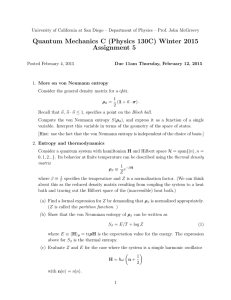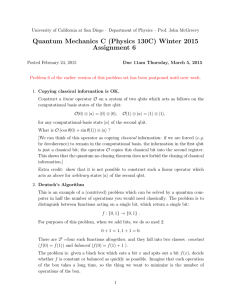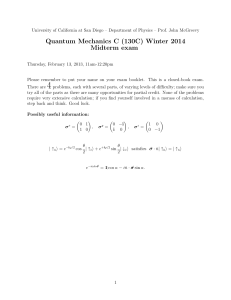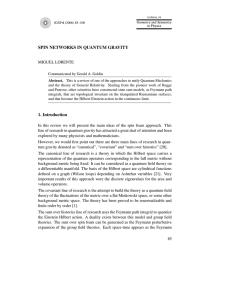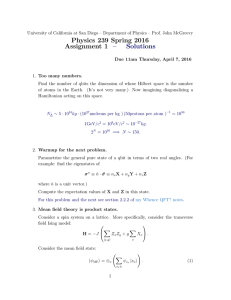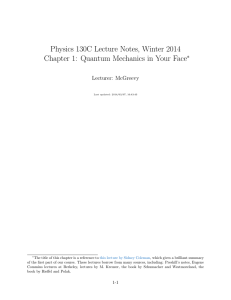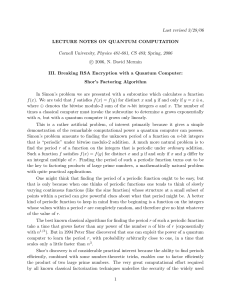Quantum Mechanics C (130C) Winter 2014 Assignment 5
advertisement
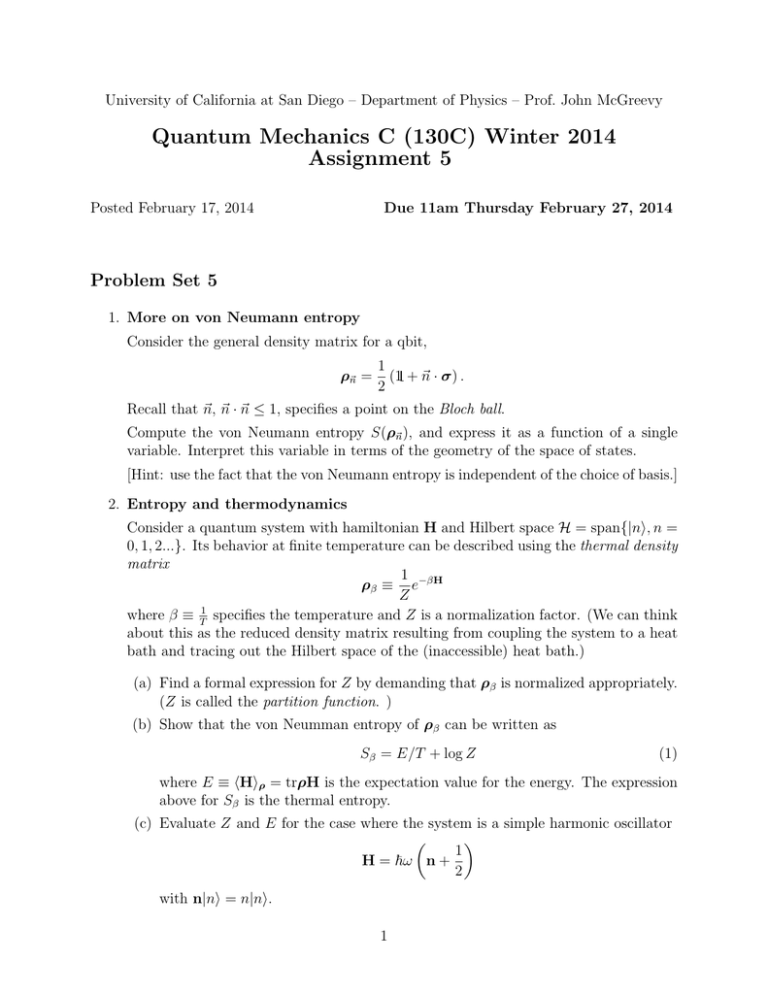
University of California at San Diego – Department of Physics – Prof. John McGreevy
Quantum Mechanics C (130C) Winter 2014
Assignment 5
Posted February 17, 2014
Due 11am Thursday February 27, 2014
Problem Set 5
1. More on von Neumann entropy
Consider the general density matrix for a qbit,
ρ~n =
1
(1 + ~n · σ) .
2
Recall that ~n, ~n · ~n ≤ 1, specifies a point on the Bloch ball.
Compute the von Neumann entropy S(ρ~n ), and express it as a function of a single
variable. Interpret this variable in terms of the geometry of the space of states.
[Hint: use the fact that the von Neumann entropy is independent of the choice of basis.]
2. Entropy and thermodynamics
Consider a quantum system with hamiltonian H and Hilbert space H = span{|ni, n =
0, 1, 2...}. Its behavior at finite temperature can be described using the thermal density
matrix
1
ρβ ≡ e−βH
Z
1
where β ≡ T specifies the temperature and Z is a normalization factor. (We can think
about this as the reduced density matrix resulting from coupling the system to a heat
bath and tracing out the Hilbert space of the (inaccessible) heat bath.)
(a) Find a formal expression for Z by demanding that ρβ is normalized appropriately.
(Z is called the partition function. )
(b) Show that the von Neumman entropy of ρβ can be written as
Sβ = E/T + log Z
(1)
where E ≡ hHiρ = trρH is the expectation value for the energy. The expression
above for Sβ is the thermal entropy.
(c) Evaluate Z and E for the case where the system is a simple harmonic oscillator
1
H = ~ω n +
2
with n|ni = n|ni.
1
[For further inquiry in this direction I recommend Schumacher and Westmoreland
sections 19.5, 19.6.]
3. Quantum gates
Schumacher and Westmoreland, Exercises 18.2, 18.6, 18.7, and 18.8, page 368. (Electronic version here.)
Regarding the SWAP gate, Schumacher’s wording is confusing and basis-dependent.
This gate is defined to act on two qbits by
S = |00ih00| + |01ih10| + |10ih01| + |11ih11|
(so in words, it acts by swapping the labels of the basis states of the tensor-product
Hilbert space). This implies (check this) that acting on product (i.e. unentangled)
states |ai ⊗ |bi it gives S|ai ⊗ |bi = |bi ⊗ |ai.
4. Copying classical information is OK.
Construct a linear operator O on a system of two qbits which acts as follows on the
computational basis states of the first qbit:
O|0i ⊗ |ai = |0i ⊗ |0i,
O|1i ⊗ |ai = |1i ⊗ |1i,
for any computational-basis state |ai of the second qbit.
What is O (cos θ|0i + sin θ|1i) ⊗ |ai ?
[We can think of this operator as copying classical information: if we are forced (e.g.
by decoherence) to remain in the computational basis, the information in the first qbit
is just a classical bit; the operator O copies this classical bit into the second register.
This shows that the quantum no-cloning theorem does not forbid the cloning of classical
information.]
Extra credit: show that it is not possible to construct such a linear operator which
acts as above for arbitrary states |ai of the second qbit.
5. Deutsch’s Algorithm
This is an example of a (contrived) problem which can be solved by a quantum computer in half the number of operations you would need classically. The problem is to
distinguish between functions acting on a single bit, which return a single bit:
f : {0, 1} → {0, 1} .
For purposes of this problem, when we add bits, we do so mod 2:
0 + 1 = 1, 1 + 1 = 0.
There are 22 =four such functions altogether, and they fall into two classes: constant
(f (0) = f (1)) and balanced (f (0) = f (1) + 1 ).
The problem is: given a black box which eats a bit x and spits out a bit f (x), decide
whether f is constant or balanced as quickly as possible. Imagine that each operation
of the box takes a long time, so the thing we want to minimize is the number of
operations of the box.
2
(a) How can you possibly answer this question without finding out both f (0) and
f (1)? Convince yourself that there is no way to do this classically in fewer than
two operations of the box.
Now suppose we have a system of two qbits: H = span{|xi ⊗ |yi, x, y ∈ {0, 1}}. We
are given a quantum black box operation (‘oracle’) Uf which acts like this:
Uf |xi|yi = |xi|y + f (x)i
on the given basis states.
To build the quantum computer we will use as the basic building block the Hadamard
gate, H ≡ √12 (|0ih0| − |1ih1| + |0ih1| + |1ih0|). Its role in life is to create and destroy
(uniform) superpositions of the given basis states.
(b) Show that H|xi =
√1
2
P
y=0,1 (−1)
xy
|yi.
Here’s the design of the quantum computer which solves the problem:
step i. Feed in the state |0i ⊗ |1i.
Now act successively with Hadamard gates on each of the two qbits:
step ii. 1 ⊗ H
step iii. H ⊗ 1
step iv. Next ‘query the oracle’, i.e. act with Uf .
step v. Now act with the Hadamard on the first qbit: (H ⊗ 1)
The following figure summarizes the steps (time runs from left to right):
[From Preskill]
(c) Find the output state of the quantum circuit:
|outi ≡ (H ⊗ 1) Uf (H ⊗ 1) (1 ⊗ H) |0i ⊗ |1i
(d) Why can we draw steps ii and iii on top of each other in the circuit diagram?
(e) We are going to measure the value of the first qbit in the output state in the
preferred basis. (That is, we measure 12 (1 − σ z ) = |1ih1|.) What are the probabilities for the outcomes 0 and 1 of this measurement in the output state |outi?
3
(f) Show that from the outcome of this measurement you can learn whether f is
constant or balanced. Notice that we only need to run the quantum black box
once!
6. An adaptation of Grover’s algorithm [extra credit]
Suppose we have a table of N items and r of them ai are marked. You are given a
quantum computer and anP
oracle which acts by a reflection in the hyperplane whose
1
√
normal vector is: |ãi = r ri=1 |ai i.
P
[These words mean that the operator is O = 1 − 2|ãihã| = 1 − 2r ri=1 |ai ihai |.]
Construct a quantum algorithm to efficiently identify the marked items, and estimate
its average time of operation as a function of r and N .
7. Stern-Gerlach for spin 1 particles
Consider a particle with spin one, with spin states which can be labelled by eigenvalues
of Jz :
Jz |mi = m|mi, m = −1, 0, 1.
A Stern-Gerlach device to measure its spin couples its position and its spin via a
non-uniform magnetic field in the ẑ direction,
∆H = λz ⊗ Jz ,
where z is the position operator in the z direction.
If the particle spends a time t in the field, and begins in the state |ψz i⊗(a| − 1i + b|0i + c|1i)
(where |ψz i is a wave packet centered about position z), describe the locations and relative intensities of the spots on the detector (as functions of a, b, c, λ, t, z). The intensity
of a spot on the detector is proportional to the number particles that have hit it.
4

